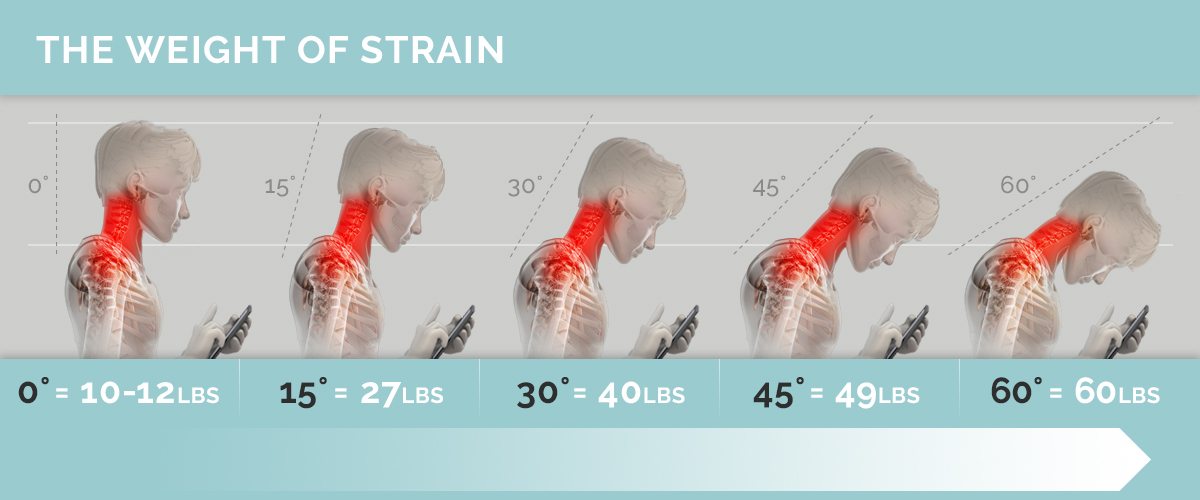Our dependence on smartphones and digital devices doesn’t show any signs of slowing, so now is the time to confront the rising tide of tech neck, which cuts across all age groups, with effective treatments and preventive strategies.
Why is the neck so susceptible to injury?
The typical adult head weighs 10-12 pounds, but when you bend it forward at a 45-degree angle, the amount of force it exerts on your neck increases to nearly 50 pounds.
Humans are upright creatures; we’re not designed to look down for long periods of time. So when we do, it puts extra pressure on the cervical spine area, which consists of seven bones (C1-C7 vertebrae) separated by discs and connected by facet joints. The vertebrae also protect the spinal cord and its many nerves.
Facet joints – two on each vertebra – are instrumental in helping us bend and move our necks freely. But when we strain or injure the facet joints, which act as passageways for nerves, the surrounding muscles in our necks naturally tighten up to try to protect them.
The result can be inflammation, pain, and knots in your neck – aka tech neck.
Of course, tech neck isn’t the only kind of neck injury or pain we see. Bone spurs, degenerative arthritis, and events such as falls, sports injuries, or car accidents can also lead to neck trauma. So can disc herniation and stenosis, or a narrowing of the spinal canal.
Most patients, however, struggle with axial neck pain, which is concentrated in the neck and is usually caused by muscle tightness and joint inflammation.
Pinpointing neck pain
Diagnosing the source of your neck pain begins with a conversation and a bit of detective work.
We’ll ask you to describe symptoms and answer some questions, such as:
- Do you have headaches or any other pain in your head?
- Does pain radiate down your arm?
- Is there numbness in your fingers?
- Was there an injury that triggered the neck pain?
- What, if anything, have you already tried to relieve the pain?
The combination of advanced imaging, a thorough physical exam, and a detailed history of the condition usually allows us to pinpoint the source of your neck pain.
Strategies to prevent or limit tech injuries:
- Head’s up phone apps signal a user when they’re tilting their head and neck forward to view the phone. A red head icon means straighten up; green is a go for good posture.
- Posture protector apps use phone technology, such as the gyroscope, to remind you not to slouch by darkening the screen when you do. Other settings can make the phone vibrate or ring instead of going dark.
- Phone and device timers are effective tools to remind you to take hourly tech breaks from working on your laptop, particularly if you’re working from home. Get up from your chair, stretch, and move to help get your neck muscles firing.
- Voice to text is another way you can reduce the amount of time you spend looking down and texting.
Simply remembering to hold your phone at eye level while texting and scrolling will go a long way toward protecting your neck. So will positioning your computer monitor or laptop at a natural horizontal eye level. Other suggestions include using a standing desk if you’re working from home. You can get an adjustable one that sits on a table or countertop for less than $50. Make sure you have adequate lighting so you don’t have to lean forward to see your screen. And find a chair that fits; no more slouching on the couch.
The Thinkers among us may wonder: Will the tech neck epidemic ever subside? But consider that technology often moves at the speed of light, and the market for augmented reality (AR) and virtual reality (VR) headsets is expected to grow tenfold in the next five years. Could it ultimately replace the smartphone? Now, there’s something to think about.
When it comes to today’s chronic neck problems, the bottom line is this: You don’t have to live with the pain.

